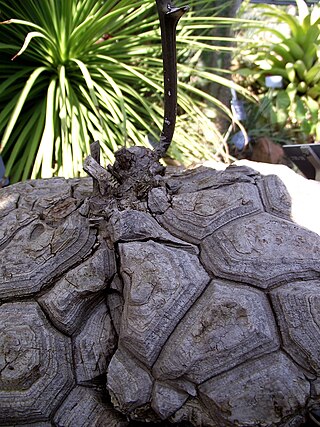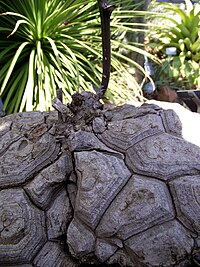
Progesterone (P4) is an endogenous steroid and progestogen sex hormone involved in the menstrual cycle, pregnancy, and embryogenesis of humans and other species. It belongs to a group of steroid hormones called the progestogens and is the major progestogen in the body. Progesterone has a variety of important functions in the body. It is also a crucial metabolic intermediate in the production of other endogenous steroids, including the sex hormones and the corticosteroids, and plays an important role in brain function as a neurosteroid.

Percy Lavon Julian was an American research chemist and a pioneer in the chemical synthesis of medicinal drugs from plants. He was the first to synthesize the natural product physostigmine and was a pioneer in the industrial large-scale chemical synthesis of the human hormones progesterone and testosterone from plant sterols such as stigmasterol and sitosterol. His work laid the foundation for the steroid drug industry's production of cortisone, other corticosteroids, and birth control pills.

Dioscorea is a genus of over 600 species of flowering plants in the family Dioscoreaceae, native throughout the tropical and warm temperate regions of the world. The vast majority of the species are tropical, with only a few species extending into temperate climates. It was named by the monk Charles Plumier after the ancient Greek physician and botanist Dioscorides.
Russell Earl Marker was an American chemist who invented the octane rating system when he was working at the Ethyl Corporation. Later in his career, he went on to found a steroid industry in Mexico when he successfully made semisynthetic progesterone from chemical constituents found in Mexican yams in a process known as Marker degradation. This eventually led to the development at Syntex of the combined oral contraceptive pill and synthetic cortisone – and to the development of the Mexican barbasco trade.

Dioscorea villosa is a species of twining tuberous vine which is native to eastern North America. It is commonly known as wild yam, colic root, rheumatism root, devil's bones, and fourleaf yam. It is common and widespread in a range stretching from Texas and Florida north to Minnesota, Ontario and Massachusetts.

Yam is the common name for some plant species in the genus Dioscorea that form edible tubers.

Luis Ernesto Miramontes Cárdenas was a Mexican chemist known as co-inventor and the first to synthesize an oral contraceptive, progestin norethisterone.

Dioscorea polystachya or Chinese yam, also called cinnamon-vine, is a species of flowering plant in the yam family. It is sometimes called Chinese potato or by its Korean name ma. It is also called huaishan in Mandarin and wàaih sāan in Cantonese.
Laboratorios Syntex SA was a pharmaceutical company formed in Mexico City in January 1944 by Russell Marker, Emeric Somlo, and Federico Lehmann to manufacture therapeutic steroids from the Mexican yams called cabeza de negro and Barbasco. The demand for barbasco by Syntex initiated the Mexican barbasco trade.

George Rosenkranz was a pioneering Hungarian-born Mexican scientist in the field of steroid chemistry, who used native Mexican plant sources as raw materials. He was born in Hungary, studied in Switzerland and emigrated to the Americas to escape the Nazis, eventually settling in Mexico.

Diosgenin, a phytosteroid sapogenin, is the product of hydrolysis by acids, strong bases, or enzymes of saponins, extracted from the tubers of Dioscorea wild yam species, such as the Kokoro. The sugar-free (aglycone) product of such hydrolysis, diosgenin is used for the commercial synthesis of cortisone, pregnenolone, progesterone, and other steroid products.
Lonchocarpus urucu, or barbasco, is plant in the family Fabaceae. It is native to the tropical forests of Peru, as well as of Brazil and Guyana, growing from 100–1,800 metres (330–5,910 ft) above sea level. It was also recorded in Venezuela.

Dioscorea mexicana, Mexican yam or cabeza de negro is a species of yam in the genus Dioscorea.
The Marker degradation is a three-step synthetic route in steroid chemistry developed by American chemist Russell Earl Marker in 1938–1940. It is used for the production of cortisone and mammalian sex hormones from plant steroids, and established Mexico as a world center for steroid production in the years immediately after World War II. The discovery of the Marker degradation allowed the production of substantial quantities of steroid hormones for the first time, and was fundamental in the development of the contraceptive pill and corticosteroid anti-inflammatory drugs. In 1999, the American Chemical Society and the Sociedad Química de México named the route as an International Historic Chemical Landmark.

Sarsasapogenin is a steroidal sapogenin, that is the aglycosidic portion of a plant saponin. It is named after sarsaparilla, a family of climbing plants found in subtropical regions. It was one of the first sapogenins to be identified, and the first spirostan steroid to be identified as such. The identification of the spirostan structure, with its ketone spiro acetal functionality, was fundamental in the development of the Marker degradation, which allowed the industrial production of progesterone and other sex hormones from plant steroids.

Nigeria is by far the world’s largest producer of yams, accounting for over 70–76 percent of the world production. According to the Food and Agriculture Organization report, in 1985, Nigeria produced 18.3 million tonnes of yam from 1.5 million hectares, representing 73.8 percent of total yam production in Africa. According to 2008 figures, yam production in Nigeria has nearly doubled since 1985, with Nigeria producing 35.017 million metric tonnes with value equivalent of US$5.654 billion. In perspective, the world's second and third largest producers of yams, Côte d'Ivoire and Ghana, only produced 6.9 and 4.8 million tonnes of yams in 2008 respectively. According to the International Institute of Tropical Agriculture, Nigeria accounted for about 70 percent of the world production amounting to 17 million tonnes from land area 2,837,000 hectares under yam cultivation.
Dioscorea composita, or barbasco, is a species of yam in the genus Dioscorea, native to Mexico. It is notable for its role in the production of diosgenin, which is a precursor for the synthesis of hormones such as progesterone. Russell Marker developed the extraction and manufacture of hormones from D. mexicana at Syntex, starting the trade of D. composita in Mexico. Marker also discovered that the composita variety had a much higher content of diosgenin than the mexicana variety, and therefore it came to replace the latter in the production of synthetic hormones.
Dioscorea zingiberensis, is a species of yam, a tuberous root vegetable. It has been cultivated in China for the production of diosgenin, an important pharmaceutical intermediate for the synthesis of steroid hormones. The rhizomes also produces steroidal saponins (TSS) as part of a treatment for cardiovascular disease.
Gabriela Soto Laveaga is a historian of science specializing in Latin America. She is currently a professor of the History of Science at Harvard University.

Dioscorea hispida, also known as the Indian three-leaved yam, is a species of yam in the genus Dioscorea, native to South and Southeast Asia. Known to be poisonous when fresh, careful processing is required to render it edible.













